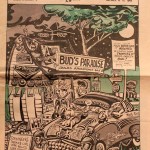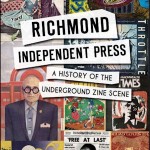By Peter Galuszka
 With its broad, tree-lined avenues, Georgian-style redbrick buildings and statues of Confederate generals, Richmond comes off a snooty and tranquil. Yet, in the words of Pulitzer Prize-winning journalist Glenn Frankel, it is a place “with larger-than-life personalities and a façade of gentility and political etiquette covering an underworld of cut-throat, back-room politics and race hatred.”
With its broad, tree-lined avenues, Georgian-style redbrick buildings and statues of Confederate generals, Richmond comes off a snooty and tranquil. Yet, in the words of Pulitzer Prize-winning journalist Glenn Frankel, it is a place “with larger-than-life personalities and a façade of gentility and political etiquette covering an underworld of cut-throat, back-room politics and race hatred.”
In other words, it can be a great place to be a journalist.
For years, however, that was hard to do. The two newspapers, the Richmond News Leader and Times-Dispatch were among the most conservative in the nation. They acted as mouthpieces for the ruling elite while pushing intellectual arguments favoring white supremacy.
Who knew that Richmond has been a hotbed of underground press activity? But it was.
Such is the theme of an intriguing new book by Dale M. Brumfield, “Richmond Independent Press, A History of the Underground Zine Scene” (The History Press). Brumfield, who, like me, contributes regularly to Style Weekly, an alternative newspaper in Richmond, was a participant back in the 1980s as an editor of “ThroTTle” magazine.
Richmond’s renegade press got its start in the Beatnik days of the 1950s when artists, writers and gays hung out at the Village Restaurant and lived in the Fan, a Victorian neighborhood with low rents that was close to the Richmond Professional Institute, now Virginia Commonwealth University.
These were the days of Massive Resistance to integration that was a state policy cheered by the Richmond daily newspapers. African-Americans protesting for civil rights could count on a whipping from Richmond cops or a bite down from police dogs if they tried a sit-in at one of the swankier, whites-only luncheonettes downtown.
In 1960, a mimeographed sheet appeared mysteriously on the city’s streets. It was titled, “The Ghost,” whose logo was a simple line drawing. It was “Published as Needed” by anonymous editors. One issue decried the fact that a basketball game between RPI and Virginia Union was canceled because “a negro” would be playing. Another story likened RPI dorm mothers to the Gestapo.
“The Ghost” vanished as quickly as it appeared. As the decade proceeded, Beatniks morphed into hippies. Around the country, new underground papers such as the “Berkeley Barb” and the “East Village Other” appeared that tried to take venerable godmother of the underground, “The Village Voice,” to radical new levels.
Richmond had its own “Sunflower” that featured psychedelic art and then “The Richmond Chronicle” that was more irreverent if not obscene, featuring R. Crump-style drawings. Much of the writing centered around the Fan and VCU, which was the old VPI. Monroe Park was famous for pot busts and the underground press openly identified narcotics agents. One newspaper enraged VCU big wigs by pushing a “puppy fry” in which a dog would be sacrificed. It was, of course, a hoax.
The most famous of the upstarts was “The Richmond Mercury” begun in the early 1970s by kin of Sidney Lewis, the famous and rich owner of Best Products and a major art collector. A bunch of Ivy League and University of Virginia grads, including Frankel, hit Richmond with tough investigative reporting uncommon in a city whose newspapers were controlled by Media General and the Bryan family.
Targets included the Chesapeake & Potomac telephone company, the State Corporation Commission, and Bill Scott, a Congressman declared the dumbest on Capitol Hill. One of the writers was Garrett Epps, a law professor who also wrote “The Shad Treatment” in 1977 which focused on the 1972 gubernatorial campaign of liberal Henry Howell and is one of the most revealing political novels ever written about Richmond and the Old Dominion.
Other off beat and provocative publications followed, including VCU’s Commonwealth Times, ThroTTle” and others that reflected the punk and heavy metal movements of the 1970s and 1980s.
These and minority newspapers like The Richmond Free Press offer a very different view than that projected by the daily newspapers and television stations. They show a special creativity and world view one wouldn’t expect in the Capital of the Confederacy. Who knew?
“Richmond Underground Press” is available online at Amazon and Barnes & Noble and at local bookstores.


